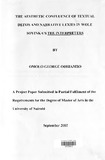| dc.description.abstract | Reading The Interpreters engages one in a juggling act. The text strikes readers as replete with shifts in narrative stances. A closer scrutiny reveals, however, that beneath these shifts lie Soyinka's artistry and nimble intellect.
In this study--"The Aesthetic Confluence of Textual Deixis and Narrative Lexies in Wole Soyinka's The Interpreters" -- we set out to examine the role of deictic features in the discourse structure of the text. Thus, the cardinal interest of this research is to highlight the prevalence of the narrative shifts and to appreciate the role of deictic features in coordinating these shifts.
We begin our critical analysis by illuminating the significance of linguistic elements as constructive units, in a literary discourse. We proceed to establish in our literature review that despite the conscious usage of deictic elements in the text, literary researchers have not focused on this important feature. This underscores the need for the current exercise and explains why we have adopted linguistic text description (textual criticism) as our theoretical framework to unravel meanings submerged by the linguistic form.
Later, as a prefatory exercise, we seek to understand Soyinka's worldview. Of particular interest here is the manner(s) in which his cultural and educational backgrounds as well as his travels and contacts nurtured his sensibilities. Emphasis is therefore put on those aspects of Soyinka's life which influence his style and thematic concerns. We relate the text's moral correspondence to this creative paradigm.
The third chapter constitutes a plunge into the textual criticism. Here, we introduce the various types of deictic features and discern their communicative efficacy. We particularly focus on how deixis defamiliarises meaning and how the allusions that it makes create suspense, among other aesthetic effects. We prove, however, that formulating a 'story' from a 'text' entails extracting details from their textuality, and that a reader should offer no less in trying to understand the novel's dehabituated realities.
Chapter four is a continuation of textual criticism. We discern from the text that the kind of reality that Soyinka depicts does not possess proximate continuity. Instead, we argue for the view that in this novel, meaning exists in a non-contiguous causal nexus. This chapter therefore unravels how the artist achieves coherence (a latent unity of narration) within this perceived discontinuity.
In the conclusion, we summarize our observations about the discoursal structure of the text. This is in no way intended to be conclusive on the text's structural design but it forms a good basis for further critical discourse. The ultimate desire of literary creativity, we surmise, is to inculcate humane values in readers and we aver, here, that the text is replete with such albeit held at some discoursal level. Cognizant of the need for literary critics with the flair for structuralism appreciation to aid readers towards this submerged content, this study deciphers moral values as advanced by deictic elements in the novel. Further, critical appreciation of this novel especially in connection with the author's metaphoric diction and hypotactic sentences could go a long way in availing Soyinka's morals to readers. | en |

